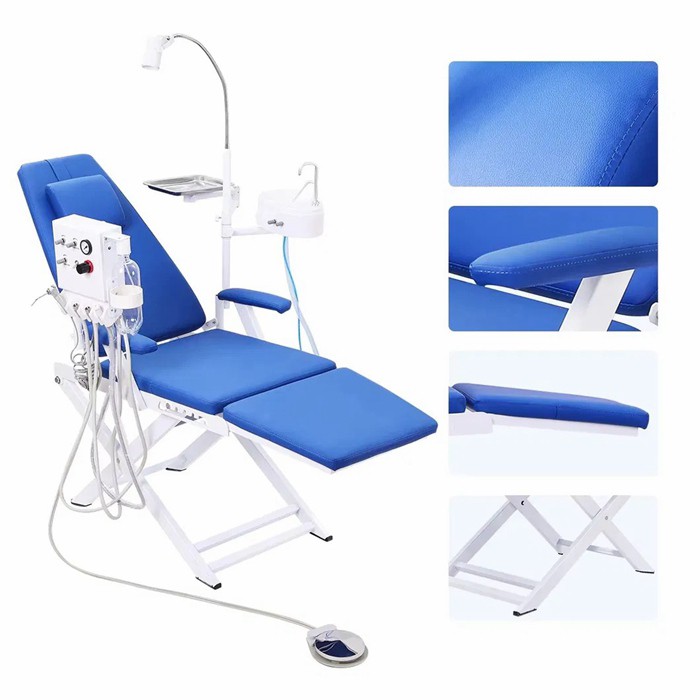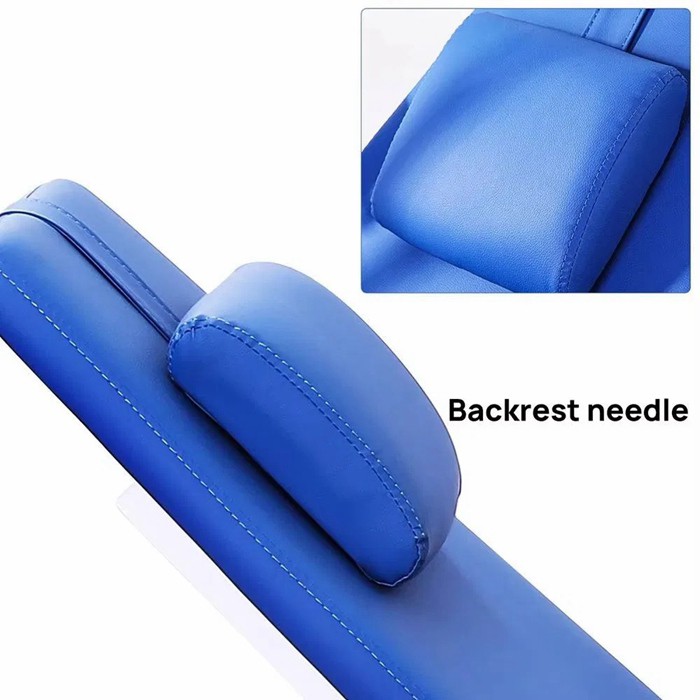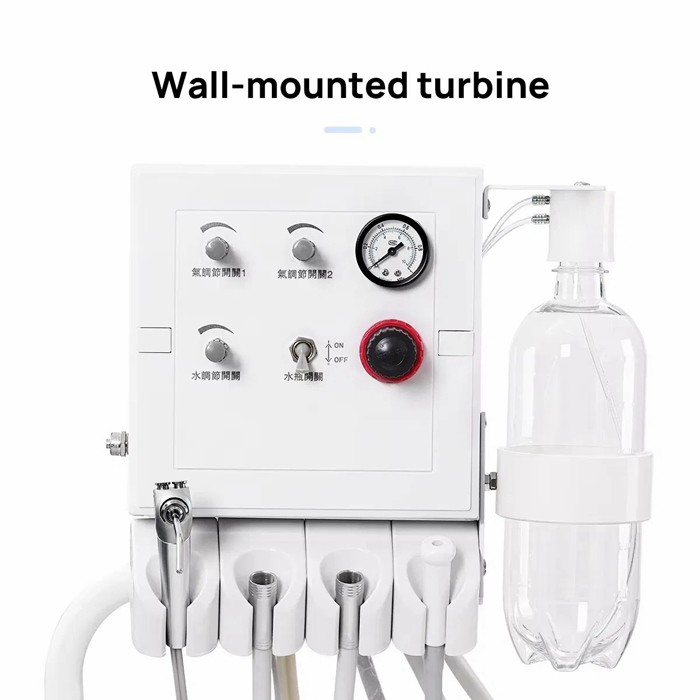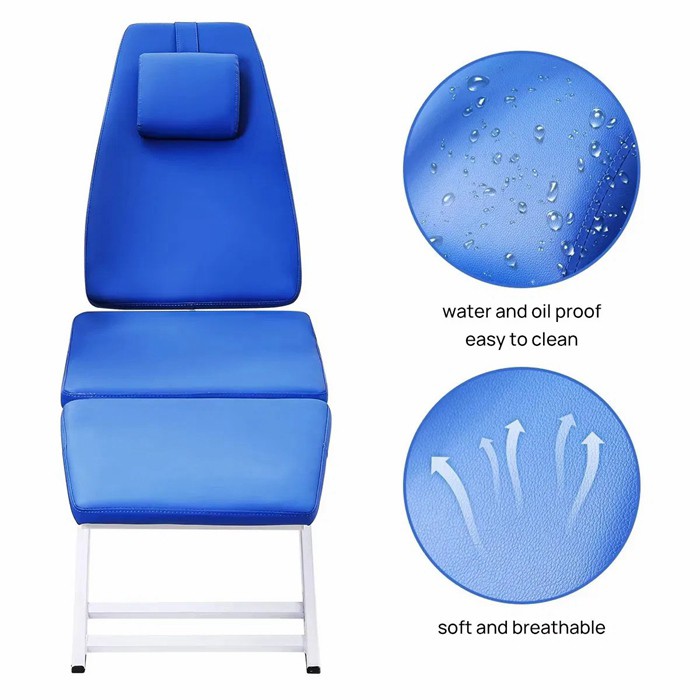How Portable Dental Chairs Are Expanding Access to Care
Product description
For decades, the dental chair stood as a fixed, bulky symbol of clinical dentistry. But innovation has introduced a game-changer: the Foldable Dental Chair. This ingenious piece of equipment retains the core functionality of its traditional counterpart while adding unprecedented portability and space-saving advantages, opening doors to care in diverse settings beyond the conventional dental office.

Breaking Free from Fixed Foundations:
Unlike standard dental chairs anchored to the floor with complex hydraulic or electrical systems, foldable chairs are designed for mobility. Their defining feature is the ability to collapse into a significantly smaller, compact form. This is achieved through innovative engineering, often involving:
Folding Mechanisms: Key sections – typically the backrest and sometimes the leg rest or entire seat base – pivot on robust hinges.
Detachable Components: Headrests, armrests, and even integrated delivery systems (if present) are often easily removable for packing.
Lightweight Materials: Strategic use of strong, lightweight alloys reduces overall weight without sacrificing patient safety or comfort.

Core Advantages: Portability and Flexibility
The foldable design unlocks powerful benefits:
Mobile Dentistry: This is the prime application. Foldable chairs are essential for:
Outreach Programs: Bringing dental care directly to schools, nursing homes, community centers, and remote or underserved areas.
Corporate/On-site Clinics: Providing convenient dental services within workplaces.
Home Visits: Enabling dentists to treat homebound patients or those with severe mobility issues.
Disaster Relief: Quickly establishing temporary dental clinics in emergency situations.
Space Optimization:
Small Clinics: Ideal for practices operating in limited square footage, freeing up valuable floor space when not in use.
Multi-Purpose Rooms: Allows a room (e.g., consultation room, staff room) to be temporarily converted into a treatment area.
Easy Storage: Folds away neatly into closets or storage areas, keeping the operatory clear.
Reduced Setup Time: Modern foldable designs prioritize quick and easy unfolding/assembly, minimizing downtime between mobile sessions or when converting spaces.

Essential Features for Functionality:
While prioritizing portability, modern foldable chairs don't compromise core needs:
Patient Comfort: Adequate padding, contoured seating, and adjustable headrests are crucial, even if simpler than fixed chairs.
Stability & Safety: Robust locking mechanisms ensure the chair is completely secure in both the open (treatment) and folded (transport/storage) positions. High weight capacity is maintained.
Essential Adjustability: Manual or simple electric adjustments (often battery-powered) for backrest recline and height are common, allowing for basic patient positioning.
Hygiene: Non-porous, wipeable upholstery (medical-grade vinyl) remains essential. Removable headrest covers facilitate thorough cleaning.
Integration Options: Many models feature attachment points or trays for portable delivery systems (holding handpieces, air/water syringes), suction units, and battery-operated LED lights.
Beyond Convenience: Expanding Access
The true impact of the foldable dental chair lies in its ability to democratize dental care. By eliminating the barrier of a fixed, expensive operatory setup, it enables care to reach populations who might otherwise go without:
Vulnerable Populations: Children in schools, elderly in care homes, individuals in rural communities.
Cost-Effective Outreach: Significantly lowers the logistical barriers for charitable organizations and public health initiatives.
Flexible Service Models: Supports innovative practice models focused on community-based care.
The Future Unfolds:
Expect continued refinement: lighter yet stronger materials, faster folding mechanisms, improved battery life for integrated systems, enhanced comfort features, and better integration with portable digital diagnostic tools (like compact X-ray sensors and intraoral cameras).


Q: How sturdy and safe is a foldable dental chair compared to a traditional one?
A: Modern foldable chairs are engineered for safety and stability. They utilize robust locking mechanisms that firmly secure the chair in both the open treatment position and during folding/unfolding. High-quality materials ensure they meet rigorous weight capacity standards (often 300+ lbs / 135+ kg), comparable to many fixed chairs. Always check the specific model's certifications and weight limits.
Q: Can foldable chairs handle complex dental procedures?
A: They are primarily designed for diagnostic exams, preventive care (cleanings, fluoride), basic restorative work (small fillings), and simple extractions. While they provide a stable platform, they may lack the extensive, ultra-precise positioning capabilities and integrated high-power delivery systems of advanced fixed chairs needed for very lengthy or highly complex surgical procedures. They excel in routine and emergency care within mobile settings.
Q: How is water and suction managed with portable chairs?
A: Foldable chairs themselves typically don't have built-in plumbing. Mobile setups rely on self-contained units:
Suction: Portable, high-volume evacuators (HVEs) and saliva ejectors run on rechargeable batteries or plug into standard outlets.
Water/Air: Portable dental delivery units (often mounted on a separate cart or attached to the chair frame) include self-contained water reservoirs and air compressors, powered similarly. Spitoon bowls utilize disposable bags.
Q: What are the main challenges of using a foldable dental chair?
A: Key considerations include:
Setup Time: Requires assembly/unfolding and connecting portable equipment (light, delivery unit, suction) at each location.
Limited Positioning: Adjustability, while present, is usually less extensive than high-end fixed chairs.
Equipment Transport: Moving the chair, delivery unit, light, suction, and instruments requires organization and suitable vehicles.
Power Dependency: Ensuring reliable power sources (batteries, outlets) for equipment is crucial in field settings.
Q: Is a foldable dental chair a good replacement for a traditional chair in a fixed clinic?
A: It depends heavily on the clinic's needs:
Yes, for specific scenarios: Ideal as a secondary chair in small clinics for overflow, hygiene, or consultations; perfect for designated mobile service days; essential for home-visit services.
Not usually, as the primary chair: For clinics focused on complex procedures requiring maximum ergonomics, advanced positioning, and integrated high-end technology, a traditional fixed chair is generally more suitable. Foldable chairs complement fixed setups by adding flexibility and outreach capacity.
Recommended products

